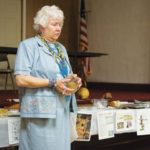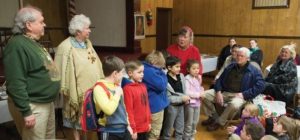Lenni-Lenape come to life
By Christopher Seamans April 19, 2016
Bridesburg Historical Society hosts presentation about first inhabitants of the River Wards.
The Messingers taught local children about the Lenni- Lenape tribe. CHRISTOPHER SEAMANS / STAR PHOTO
Carla Messinger donned full Lenape regalia at the event. CHRISTOPHER SEAMANS / STAR PHOTO
 Last Wednesday, April 13, the hall at Point No Point Republican Club, 2843 Orthodox St., became a kind of time machine, offering the audience a look back at the world of the area’s native people.
Last Wednesday, April 13, the hall at Point No Point Republican Club, 2843 Orthodox St., became a kind of time machine, offering the audience a look back at the world of the area’s native people.
The Bridesburg Historical Society invited Carla and Allan Messinger of Native American Heritage Programs to give a presentation about the first inhabitants of the region — the Lenape tribe.
Carla Messinger, the director of the organization, is a descendant of the Lenape tribe herself, while Allan is a historian. Together, they are devoted to offering an accurate portrayal of early Native American life, devoid of stereotypes.
The Lenape, sometimes called the Delaware Indians or the Lenni-Lenape, are a Native American tribe that once lived in New Jersey, eastern Pennsylvania and part of New York’s Hudson Valley. Although largely gone from the area today, maps still bear their mark — place names like Manhattan, Rockaway, Hoboken, and Absecon are derived from their language.
From Manayunk and Passyunk to Tacony and Pennypack, Philadelphia and the surrounding area are rich with reminders of the Lenape.
The River Wards are no different.
Most of what we know as the River Wards today was known to the Lenape as Shackamaxon. Penn Treaty Park, where William Penn made his famous treaty with Tamanend, chief of the Lenape Turtle Clan, is a Fishtown institution.
Like most Native American tribes, the Lenape were ravaged by smallpox when the Europeans first arrived. However, the Quakers who settled in Penn’s colony tended to treat the natives more fairly than those in other colonies.
“Pennsylvania was the only colony that didn’t have wars with the Native Americans right away,” Allan Messinger said.
Many moved out of the region, and over the following centuries, they were driven further and further west. Others tried to assimilate.
“They combed their hair like Europeans and dressed in European clothes,” Allan Messinger explained, “even though they didn’t all become Christians.”
Point No Point filled up quickly as the starting time approached.
By the time the Messingers were ready to give their presentation, organizers from the BHS scrambled to pull more chairs out of storage. Children gathered on the floor near the front of the hall.
The Messingers’ presentation was far-ranging, touching on the animals associated with the Lenape, the tribe’s history and craftsmanship, and the impact of animals, pelts, and food crops from the Americas on Europe.
They displayed pelts and feathers to the audience as they explained the importance of the area’s wildlife to the tribe.
For example, they described how the deer, the “buffalo of the east,” provided the Lenape not only with meat, but with hide for clothing and moccasins, antlers and hooves for utensils, and sinew for stitching and cord.
They also talked about the respect the Lenape had for the skunk. Seemingly humble and able to excrete a foul-smelling musk, the skunk is actually a fearless animal capable of sending even the mighty bear running.
Other animals they discussed were the raccoon, the bear, the fox and the beaver.
They also talked about how the animals and crops of the Americas impacted Europe over the centuries, from the introduction of beaver hats that became so valuable that fathers would specifically pass them onto sons in their will, to raccoons that were transplanted to Germany and have proved impossible to get rid of.
Today, tomatoes are associated with Italians, chocolate with Central Europe, and the potato with a number of European cultures. However, these crops were unknown in Europe until brought back from the Americas. Allan Messinger pointed out that everyday foods like pizza and chocolate bars have their roots in Native American agriculture.
The couple also demonstrated Lenape artifacts for the crowd, from drinking utensils made from gourds and deer hooves to a tomahawk that doubled as a tobacco pipe.
A highlight of the evening was when Carla Messinger put on full Lenape regalia.
At the end of the presentation, Kathleen O’Hanlon, president of the Bridesburg Historical Society, called several of the children up to the front of the hall to recite Annette Wynne’s early 20th century poem “Indian Children” as a special thank you to the speakers.
After the presentation, audience members were invited up to the front of the hall for a closer look at the Lenape artifacts and were offered refreshments by the group.
Carla Messinger was pleased at the turnout.
“I’m thrilled,” she said, “and we love having children. Our programs are reviewed by teachers, librarians, and special-ed teachers, so that it meets core curriculum and academic standards.”
She explained that children and adults alike who might be interested in learning more about the Lenape visit her website where they can find not only information, but book lists for readers.
“We have everything from children’s stuff right through to adults’,” she said, “so there’s a whole progressive wave of books depending on what level you’re interested in.”
For those interested in a more advanced look at Lenape culture, Allan Messinger recommended an English-Lenape/Lenape-English dictionary as well submitting as requests for materials from the Moravian Archives in Bethlehem, Pennsylvania. He explained that the Moravian Church was among the most respectful sects when dealing with the Lenape.
O’Hanlon was pleased with the event, calling it a success.
She was especially happy with how many children attended.
“They brought brothers and sisters with them, and they all were interested in learning about the heritage of their neighborhood,” she said. “It’s so important to preserve the heritage of our River Wards and we want to the next generation to pick that up, so it was nice to have the children here, so they can see what we do.”
The Bridesburg Historical Society usually holds events at 7 p.m. on the second Wednesday of each month at St. John Cantius Church Hall. In May, the organization will host Michael Frechette, who digs up the history of the River Wards one outhouse at a time.
http://www.starnewsphilly.com/2016/apr/19/lenni-lenape-come-life/#.Vxa4C4-
